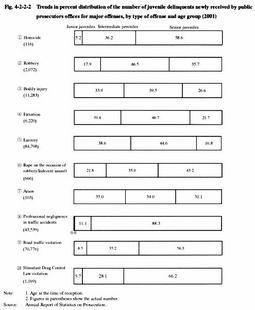| Previous Next Index Image Index Year Selection | |
|
|
1 Prosecution in juvenile cases Fig. 4-2-2-1 shows the trend the number of juvenile delinquents newly received by public prosecutors offices (excluding those received for professional negligence in traffic accidents and road traffic violations) in the last 10 years, by age group. In each age group, the number showed a downward trend until 1995, and an upward trend from 1995 through 1998 thereafter. Then, it showed a downward trend from 1998 through 2000. In 2001, however, it showed an upward trend again, by 0.8% for junior juveniles, 6.6% for intermediate juveniles and 4.7% for senior juveniles from the previous year.
Fig. 4-2-2-1 Trends in number of juveniles newly received by public prosecutors offices, by age group (1992-2001) Fig. 4-2-2-2 shows the trend in the percent distribution of the number of juvenile delinquents newly received by public prosecutors offices for major offenses in 2001, by type of offense and age group (see Appendix 4-7 ). Regarding homicide, rape/indecent assault, professional negligence in traffic accidents road traffic violations, and Stimulant Drug Control Law violations, senior juveniles had the highest percentage; as for robbery, bodily injury, extortion, and larceny, intermediate juveniles had the highest; and regarding arson, junior juveniles had the highest. Also, comparing 2001 with the previous year, there is a 23.2 point increase for senior juveniles regarding homicide (actual number is 29 persons), a 2.5 point increase for intermediate juveniles regarding robbery (70 persons), and a 6.4 point increase for junior juveniles regarding arson (12 persons).A public prosecutor attaches his or her opinion about the treatment of juveniles when the public prosecutor refers the juvenile case to a family court. Out of the number of final disposal by the family courts pertaining to penal code and special law except those received for professional negligence in traffic accidents and road traffic violation in 2001, the percent distribution of each opinion attached by the public prosecutor regarding appropriate measures such as criminal punishment, commitment to juvenile training schools, or probation, is shown in Appendix 4-8 . Fig. 4-2-2-2 Trends in percent distribution of the number of juvenile delinquents newly received by public prosecutors offices for major offenses, by type of offense and age group (2001) Table 4-2-2-3 shows the disposal situation at public prosecutors offices for the juvenile cases that were transferred to the public prosecutors by the family courts in 2001. The rate of those who were brought to trial out of prosecuted juveniles is 6.5% in total (57.0% for penal code offenses, 1.6% for special law offenses), 2.7 points up in total (9.1 points for penal code offenses, 1.0 point for special law offenses) from the previous year.Table 4-2-2-3 Number of persons transferred to and disposed by public prosecutors offices, by type of offense |


